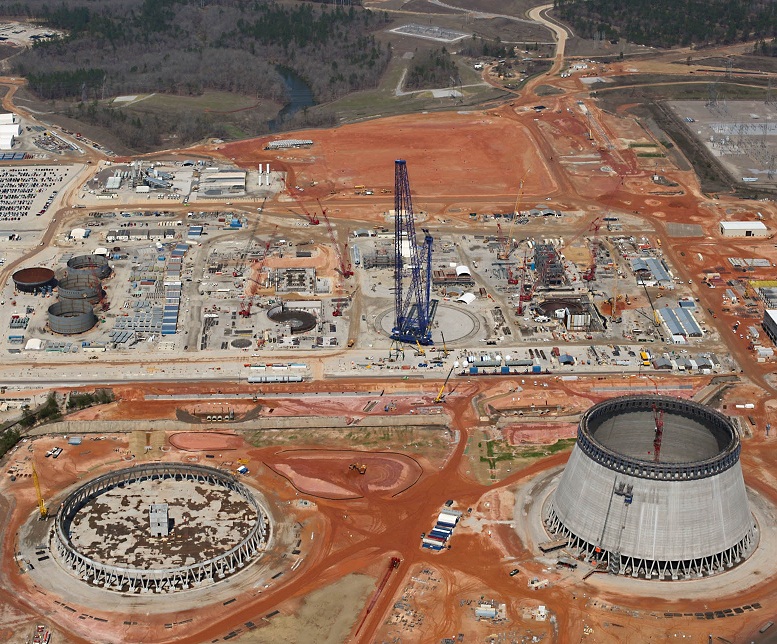Lot's happening with nuclear around the world -- mostly associated with continued problems with market-competitive delivery, seeking alms from taxpayers, and attempts by taxpayer groups and trading partners to block the largest of the subsidies.
1) Prefab reactors not so cheap. The Wall Street Journal notes that even though utilities promised modular construction of reactors would bring construction costs down, it has not worked out that way. Two reactors, Vogtle in Georgia and Summer in South Carolina, both rely on Westinghouse designs, which is owned by Toshiba. Although the reactors are designed to use modular construction, there are 2,000 separate modules, each of which must meet stringent safety and production requirements. Proponents say they are still along the learning curve, and soon (yes, very soon) the promise of these new methods will be realized and unit costs will fall. In the meantime, costs are ballooning.
In other news, Toshiba's top executives resigned last week due to a massive accounting scandal that overstated earnings from multiple divisions (including nuclear) by more than $1.2 billion over the past 7 years.
2) Small modular reactors not so cheap. Another main thread of the industry's effort to convince politicians and Wall Street (though mostly, I suspect politicians) that they can build cost-effective reactors has been small modular reactors. Build them standardized, in a factory production line, and unit costs will fall. Kind of like, I don't know...photovoltaic panels, though just with way fewer manufacturers, and way, way smaller production runs. The talking points have had some success. Bill Gates has dumped a chunk of cash into modular nukes. Boston-based entreprenuer Russ Wilcox, who's former firm e-ink brought us many of the crisp text displays we take for granted on text readers today, seems to be investing a sizable chunk of his fortune into nuclear startup Transatomic Power. He acknowledged in a panel discussion I heard at Harvard Business School that any solution he came up with would be more than a decade away, and that the delivery lead time would be a factor in its usefulness for dealing with climate change. I suppose if these folks are kicking in their own money, best of luck to them. But the history of nuclear power is that much of the risk and cost always seem to end up in the lap of taxpayers. The push for small reactors is likely to be the same.
Small nukes have caught the imagination of some of the folks at Harvard Business School as well. They have written recent business school cases on TerraPower, NuScale Power; Professor Joe Lassiter has been writing a great deal about the topic in other venues, and hosting many panels on it as well. He summarizes his thinking on nuclear here and here. In this piece, he articulates his view that new reactors could be the miracle to save the world from climate change. The reason we've not seen these miracle boxes already?
The barriers to rapid progress in New Nuclear are not technical, not even economic. The barriers are in the outdated nuclear regulations that scare off private investors and in the nuclear industry-regulatory culture that accepts timelines measured in decades as normal.
I don't think NEI could have said it better. While some of the technologies Lassiter is pushing could potentially provide some benefits to energy markets, he is understating (dramatically) the problems the sector has with cost, waste management, and proliferation should construction and deployment or reactors expand broadly. He is also underestimating the ability of smaller scale, lower risk renewable technologies to scale in a period far shorter than what the nuclear sector has a prayer of achieving. Wall Street has already signalled its unwillingness to be the one left holding the bag for missed milestones and cost overruns that make the fully-loaded cost of power to expensive to sell. I doubt even Bill Gates can carry the ball here; his total net worth of $80 billion seems big until one looks at the history of write-offs in the nuclear sector.
The enthusiam of these folks for modular reactors begs one additional question: why now? With more than sixty years of economic trends in nuclear moving the other way -- to ever larger reactors in order to spread massive fixed costs over ever more kWh -- what has suddenly changed? It's not as though production line manufacturing has just been invented, after all.
Enter Princeton University nuclear researcher M.V. Ramana with a nice dose of reality. In the nuclear arena, virtually no path has been left unexplored technologically and trolled for government largesse. Small reactors are no different -- and Ramana has written the best summary of small reactor economics that I've seen. He provides a great historical review of past efforts by the industry to build small reactors, why they failed, and why they are likely to fail now. Read the whole thing. Here's hoping that at one of his upcoming panels, Professor Lassiter saves a seat at the table for Dr. Ramana so there can be a real debate.
3) More cracks in the French model. The US industry often claims a pernicious regulatory environment is behind their cost travails; if only they didn't have to waste money on the needless bureaucratic meddling and civilian attempts to slow their work via lawsuits, the projects would be cost-competitive and operating years earlier. France is held up as the model for appropriate regulation, allowing reactors to succeed. Alas, it turns our letting businesses get on with business doesn't always work so well, even in France:
Areva, France's nuclear giant, has been aware since 2006 that the steel vessel of its flagship new-generation reactors that confines radioactivity is faulty...Until now, it was thought that Areva had only recently become aware of "very serious" anomalies in its 9 billion Euro (6.5 billion pound) European Pressurised Reactor, or EPR -- the same model sold to Britain. The EPR is being built in Falmanville on France's Channel Coast.
In April, it was revealed that excessive amounts of carbon in the steel in the top and bottom of the reactor's vessel, which forms a shell around it, could cause cracks which could prove disastrous, since the vessel, which houses nuclear fuel, cannot be replaced during the lifespan of the reactor.
Oops. Areva, of course, says it did nothing wrong and hid nothing. But what do you do when there are basic engineering flaws that a company knew about for nearly 10 years and said nothing -- continuing to collect money from customers and potentially putting millions of people at risk? Well, this France and Areva is a national champion: they plan to bail them out with public money by effectively merging Areva and EDF:
The deal would not make the order books look better by ramping up international demand. Instead, it would absorb losses by spreading them across the merged new company -- and eventually transferring them (at least in part) into tax budgets...[T]he bailout may eventually add up to more than 10 billion euros.
4) Third Vogtle partner gets its free government nuclear loan guarantee; costs to ratepayers continues to rise. The US Department of Energy finalized the third and last tranche of its $8.3 billion loan guarantee to build Vogtle 3 and 4 in the US state of Georgia. Backstopping the borrowing of the first two partners (Georgia Power and Oglethorpe Power) was done with zero credit subsidy fee based on justifications that remain secret to this day. The third partner, the Municipal Electric Authority of Georgia (MEAG) closed on its $1.8 billion piece of the action last month. No word yet on whether it, also, received a guarantee with zero credit subsidy fee.
MEAG the borrower is actually different from MEAG the Electric Authority, as it created three separate special purpose vehicles for the Vogtle project. How these separate entities benefit from the loan guarantee, how they have demonstrated financial strength, and how the project company assets would play out in a bankruptcy is buried somewhere in the final agreement documents that remain a closely held secret of DOE.
Minority partner Dalton Utilities did not apply for a share of the federal loan guarantee that is protecting all of the other project investors. Time will tell whether that oversight will be a painful one for the ratepayers in Dalton's service area.
The Vogtle project cost overruns and time delays continue to mount, and will result in additional charges to customers both from financing costs and replacement power since the promised power from the new reactors is delayed by years. Alison Chiock, Georgia Power's director of resource policy and planning acknowledged the cost increases, but pushed back on criticism noting that "You lose sight of the 60-year benefit when you sit here in 2015 and focus on those schedule changes."
She noted that customers will still come out $3 billion ahead over the life of the plant relative to a natural gas plant. Walter C. Jones of the Athens Banner-Herald noted in return "that lifespan benefit shrunk by $2 billion just since the last semiannual construction-monitoring report due to a drop in the price of natural gas." It is highly likely that continued delays and cost overruns will erode this benefit still further before opening day.
4) Octogenarian reactors. Hey, we all hope to live to be 80 or older, and still be spry in mind and body. Who can fault your friendly neighborhood reactor for wanting the same? How many more happy days and nights these reactors could share with us, lighting up our world, avoiding carbon, accruing 0.1 c/kWh for the cost of the government taking care of their nasties (oh, forget that; the fee was canceled), and lots more time to build those decommissioning trusts funds and continue to provide retrospective premiums under the government's subsidized accident liability scheme. The additional four decades just might even be enough to keep the industry alive so the next generation (the better, safer, cheaper ones) enter the market.
Alas, like the human body, reactors don't tend to age too well. Indeed, the aging process drives up both the maintenance costs and the risks of serious problems. Hopefully the former would trigger closure before the latter.
Here's a nice summary of the issue at the GreenWorld Blog, as well as the mandatory NEI happy quote:
Much work remains to be done, but early results indicate that there are no generic technical reasons to prevent well-maintained nuclear power plants from operating beyond 60 years…
Let's review the all of the hedging language in this one mere sentence: "early results" mean we haven't studied the problem that carefully yet, though clearly many aging reactors have had problems with brittleness and cracks; "no generic technical reasons" leaves the many site-specific issues associated with the wide variety of US installations wide open as a source of problems; "well-maintained nuclear power plants" -- I'm guessing the horse has already left the barn on this issue for some US reactors.
While waiting for the NRC to do the "much research," we ought to be starting to track maintenance spending and insurance costs for the oldest reactor cohorts. Those financial signals will be taken a great deal more seriously than industry PR pieces.
5) Sordid tales of political deceit in the Uranium industry. This stuff is hard to make up. According to the New York Times (kudos to reporters Jo Becker and Mike McIntire for their detailed sleuthing), the following events have unfolded:
- Russian atomic agency Rosatom gradually acquired a majority stake in Canadian uranium company Uranium One. The deal gave Russia substantial uranium assets in many parts of the world, including Canada, Kazakhstan, and South Africa. The deal also gave Russia control of 20% of the US' uranium reserves.
- Background work to facilitate the first deal in this industry roll-up was done by former President Bill Clinton back in 2005, when he and Canadian mining financier Frank Guistra met privately with Kazakh president Nursultan Nazarbayev. Clinton expressed support for Nazarbayev president to head an international elections monitoring group, counter to US policy. Days later, Giustra's company UrAsia Energy Ltd. got a deal allowing it to buy stakes in three state-controlled mines. In 2007, Guistra's firm merged with South African company Uranium One, gaining additional stakes around the world. It continued to acquire additional uranium minin interests around the world in the ensuing years.
- Uranium One ran into financial and legal trouble as markets shifted and its Kazakh purchases were declared illegal and a key official arrested. Leaked documents indicated a concern of the US government that Russia had orchestrated the arrests as a way to achieve control of the uranium assets, noting that Vladimir Putin was concerned Russia's domestic uranium reserves were too low. Rosatom bought a minority stake in Uranium One in 2009; a year later, it moved for control (at 51%). Because of the US holdings, the controlling interest required approval by the US government -- specifically by the Committee on Foreign Investment in the United States. Key cabinet members, including then Secretary of State Hilary Clinton, were on the committee.
- Significant direct contributions to, and fundraising on behalf of, the Clinton Foundation were done by a variety of players involved with Uranium One. A fundraiser for the Foundation led by Guistra five months after the deal with Kazakhstan was completed brought in $16 million. Ian Telfer, the chairman of Uranium One after the Russian's assumed control, dontated directly and through his family's Fernwood Foundation millions of additional dollars. Between $1.3 million and $5.6 million of these donations were not disclosed by the Clinton Foundation as had been required under a deal Mrs. Clinton made with the Obama administration prior to taking up her role as Secretary of State. There was also a large speaking fee paid to Bill Clinton by one of the Russian banks with ties to the deal. The Clinton Foundation says the lack of notification on some of the donations was an oversight, and that they did nothing untowards.
There are a number of interesting aspects of this story beyond the fascinating details:
- Nuclear power is never a "normal" market and never will be. The connection between the power sector, weapons, and perceptions of state power from nuclear capabilities mean that governments will continue to intervene in market structure and make all sorts of decisions to keep them "in the game". The economics of nuclear power will be distorted in significant ways from these decisions, interfering with the risks and returns of competing forms of energy and other energy sector objectives.
- The control of known uranium reserves sought by Russia probably doesn't mean that much in terms of market power. Uranium markets have been depressed for a long time, and investments into finding, re-establishing, or improving known deposits has not been robust. Here's a story from 2012 indicating that, indeed, there is more uranium than people think; rising prices would further accelerate that process. Further, significant value-added arises at the enrichment stage, and even after enrichment, the uranium component is not a significant fraction of the cost of nuclear power. The risks to me from this deal seem fairly low.
- The failures of disclosure associated with the Clinton Foundation are quite troubling, and a more robust system should have been in place not only to report donations retrospectively, but also in a way that links activities of the foundation to possibly related contributions from parties or countries related to those activities. That said, the fact that the Clinton Foundation reports donations from foreign entities at all is uncommon. It is a huge improvement over what nearly all other foundations and trade associations do. How interesting it would have been to see flows of money to the Carter Foundation, for example, when it releases particular books, or observes elections in particular (democratically-challenged) countries. Or to see flows of foreign donations to the Nuclear Energy Institute when foreign firms were applying for large federal loan guarantees or hoping to get approval for US-based reactors or enrichment facilities a few years ago.
6) Austria files challenge to UK nuke subsidies to Hinkley Point C. This follows a similar challenge launched two weeks earlier by ten German and Austrian energy companies. All argue that the UK funding to build two new reactors, including 35-year above market price guarantees for the power the reactors produce -- the UK's so-called "contract for difference" policy. The UK was adament that this policy was not a subsidy (see my parsing of the bull here); it's nice to see so many others disagree. Austrian chancellor Werner Faymann minces no words:
Subsidies are there to support modern technologies that lie in the general interest of all EU member states. This is not the case with nuclear power.






